4 AdWords Geo‑Targeting Tactics To Optimize Across Multiple Locations
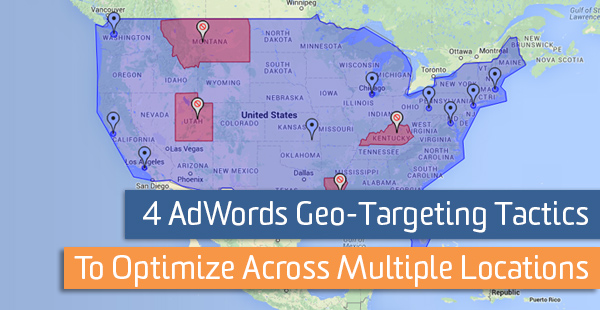
Tell me if this scenario sounds familiar. You want to build Google AdWords campaigns focused on your core audience and their associated geographic location. ROAS is of high importance and you want to focus on conversion optimization as a result.
You also know that Google AdWords plays a large role in generating demand for your products, so brand awareness and overall ad reach are both important to you as well.
Expectations are high. You’re feeling overwhelmed. You’re not sure where to start.
Relax. Take a deep breath. You’re not the only one. Plus, you’ve come to the right place.
The four options below are all designed with the same goal in mind: maximize our return on ad spend by focusing on both conversion rate optimization and brand awareness.
We want to hone in on the best performing areas by geo-targeting to the regions where conversions are strongest. At the same time, we still want our ads to show in other regions to help generate demand via brand awareness. In other words, we want to more competitive where it matters most but still cast a wide net.
It’s a tricky scenario, but not an impossible one.
All four approaches here accomplish the same task but with varying levels of complexity, budget and bid control, and investment of time. It’s up to you to decide on which method works best with your unique circumstances. As with all things AdWords there are an abundance of options. It’s just a matter of choosing which works best for you.
One Campaign Using Geographic Bid Adjustments



In this scenario we will create a single campaign in our account. Within the geo-targeting settings we select the specific areas where conversion rate is [presumably] highest and increase our bids in those areas.
We can also select the areas where performance isn’t the best but it is still important for our ads to display because these users are within our serviceable area. For example, I may target Pennsylvania, Ohio, and the United States all within the same campaign but adjust my bids 25% higher for PA and OH because I’ve identified them as the best performers.
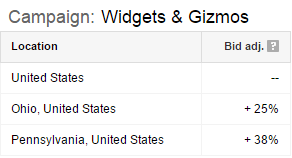
Pros: This strategy is the easiest to manage and least time consuming in the long-run. If you’re new to AdWords or briefly testing a hypothesis, I might start here.
Cons: Less control over the budget. If we think about our goals – CRO and demand generation – these represent users at opposite ends of the conversion funnel. This strategy doesn’t allow for segmentation of the budget to focus on these goals independently. We also lack the ability to develop custom creative to address these very different users in this case.
Two Campaigns, Each Targeting Multiple Regions



In this scenario we will create two separate campaigns targeting identical keywords. Because each campaign targets different regions, there is no “internal competition” within the account.
Campaign #1 will focus on the geographic regions where conversion rates, total goal completions, or revenue have been proven to be strongest. Campaign #2 will focus on the regions where conversion rate isn’t quite as strong but where we are attempting to generate demand with a focus on brand awareness.
For example, I may target Pennsylvania and Ohio (which I’ve identified to be the best performers) in Campaign #1, then target the rest of the United States in Campaign #2.
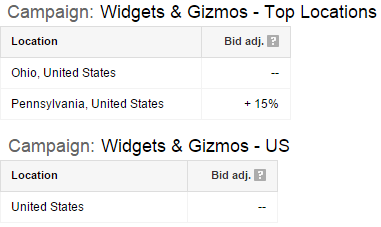
Pros: Greater control over the budget. More advertising dollars can be spent where it matters most. I would devote the majority of my budget here to conversion-focused Campaign #1 because it is a revenue driver in terms of sales, lead generation, or other valuable on-site actions. We also have more control over which ad messaging is deliver each geographic region.
Cons: Slightly more complex and time-consuming than the previous example. This is still quite manageable for the average user depending on the overall number of campaigns in your account.
Multiple Campaigns, Each Targeting a Single Region



Very similar to the previous strategy except we are targeting only a single region within every campaign, of which there can be many more than two. However, this concept doesn’t necessarily need to be taken to the extreme.
Perhaps you break out 3 or 4 of your best performing geos while bucketing the remaining ones per the aforementioned strategies. For example, I may target Pennsylvania and Ohio in two separate campaigns while targeting the rest of the United States in a third campaign.
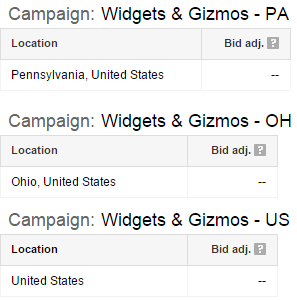
Pros: Very high level of control over the budget and the message being served in select areas. In this scenario, we now also have far more control over our bids in particular areas. Rather than relying on bid adjustments to do the work for us, we can hone in one what works best in each instance.
Cons: This strategy can become very time consuming if you have identified numerous geos to target.
Multiple Campaigns, Each Targeting Multiple Regions with Bid Adjustments



The idea here is essentially a mash-up of all previously mentioned strategies.
Here we have broken our campaigns out into very specific geo-segments, then we segment again within the campaign to even more granular levels based on the most specific data we have available. For example, I may target Pennsylvania at large then adjust bids on certain cities or zip codes within PA. I would then continue building campaigns for my other top geographic regions.
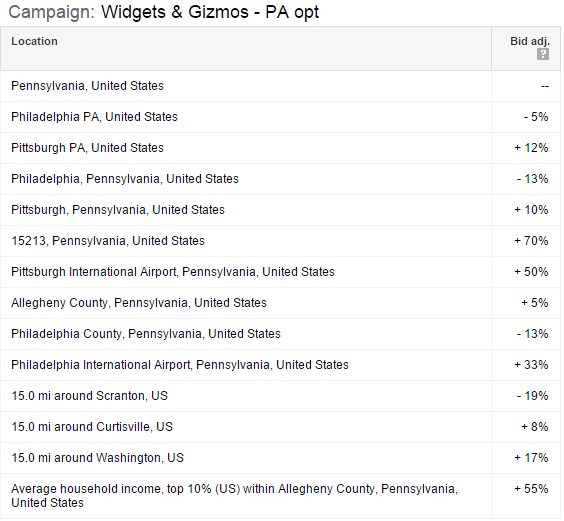
Pros: This is AdWords on steroids. This strategy gives you a very high level of control over how your budgets are spent and even more control over your CPCs in those targeted regions.
Cons: This can become very labor-intensive, very quickly. From a scalability standpoint, you should ensure that you have the resources to support regular maintenance on such an endeavor. If you’re making a lot of ad copy updates you may want to avoid getting so granular because your ad groups can compound quickly.
The Choice Is Yours
Just remember when you’re considering implementing these tactics that you don’t need to jump to the most advanced scenario every time. Think about your resources and how you manage your account before turning one campaign with 5 ad groups into 50 campaigns with 250 ad groups. Even more importantly, ensure that you have significant data that demonstrates you have a need to go with more complexity.
The best recommendation is always to test first, collect data, then move forward or try something new.
—
Like what you’ve read? Leave a comment below.